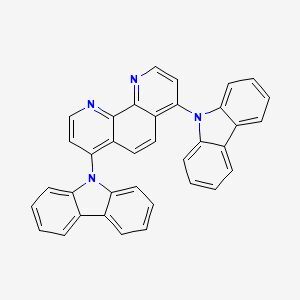BUPH1
Properties
| Signal Word | Warning |
Product Description
BUPH1, scientifically referred to as 4,7-Di(9H-carbazol-9-yl)-1,10-phenanthroline, is a complex organic compound engineered for applications in optoelectronics and material science. Its structure combines phenanthroline with carbazole units, offering enhanced properties such as high thermal stability, excellent hole transport capabilities, and efficient luminescence. These attributes make BUPH1 particularly effective in the development of advanced electronic devices, including those requiring efficient charge transport mechanisms and stable light-emitting properties.
Application
BUPH1 is primarily employed in the production of Organic Light Emitting Diodes (OLEDs), where it contributes to improved device efficiency and operational lifetime. Its superior hole transport properties enhance the overall brightness and energy efficiency of OLED displays. Additionally, BUPH1 plays a crucial role in the formulation of organic semiconductors, contributing to the performance of various optoelectronic technologies through its ability to facilitate charge transport. Furthermore, its luminescent properties make it suitable for applications in sensors and photonic devices, offering potential for high sensitivity and selectivity in detection systems.
Articles:
- Contrasting photophysical properties of rhenium(i) tricarbonyl complexes having carbazole groups attached to the polypyridine ligand
Publication Date: 04 May 2016
L. D. Ramos, R. N. Sampaio, F. F. de Assis, K. T. de Oliveira, P. Homem-de-Mello, A. O. T. Patrocinio and K. P. M. Frin
https://doi.org/10.1039/C6DT01112H
- Synthesis and Electrochemical and Spectroscopic Characterization of 4,7-diamino-1,10-phenanthrolines and Their Precursors
Publication Date: 13 November 2019
Jacek E. Nycz, Jakub Wantulok, Romana Sokolova, Lukasz Pajchel, Marek Stankevič, Marcin Szala, Jan Grzegorz Malecki and Daniel Swoboda
https://doi.org/10.3390/molecules24224102
- Understanding coordination reaction for producing stable electrode with various low work functions
Publication Date: 24 July 2020
Hirohiko Fukagawa, Kazuma Suzuki, Hirokazu Ito, Kaito Inagaki, Tsubasa Sasaki, Taku Oono, Munehiro Hasegawa, Katsuyuki Morii & Takahisa Shimizu
